Algebra | Term 3 Chapter 3 | 7th Maths - Geometrical Approach to Multiplication of Monomials | 7th Maths : Term 3 Unit 3 : Algebra
Chapter: 7th Maths : Term 3 Unit 3 : Algebra
Geometrical Approach to Multiplication of Monomials
Geometrical Approach to Multiplication of Monomials
We have already learnt that the operation
of multiplication can be modelled in different ways. The one that we use in this
unit is the representation of multiplication as a product table that is similar
to area.
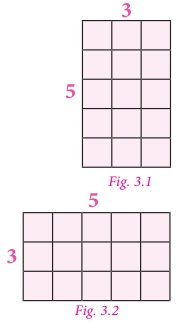
For example, the product 5×3 can be represented
as shown in Fig. 3.1, which has five rows and three columns and it comprises 15
small squares. From Fig. 3.2, it is also clear that the product of 5×3 is the same
as the product of 3×5 [Since, multiplication is commutative].
Here, multiplication is represented using grid model. The same can be represented using area model.
The area model helps us to understand
multiplication by decomposing the area of large rectangle into areas of smaller
rectangles. Also the same example which is discussed above may be decomposed as
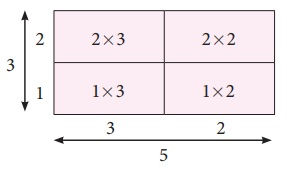
5×3 =(2×3) + (2×2)
+ (1×3)
+ (1×2)
= 6+4+3+2
=15
This decomposition model is very useful
when we are finding the product of large numbers.
Think
Is it the only way to decompose
the numbers representing length and breadth? Discuss.
Solution: No, for example 15 can be decompose into 1 × 15,
3 × 5, 5 × 3, 15 × 1
Note
It can be practiced not
to draw the area models in proportions to the numbers, since it stimulates abstract
representation.
Let us try to extend this concept of
multiplication for variables.
Take few tiles in rectangular shape of
length ‘x’ and breadth ‘y’. Also the area of one
tile is xy (  ).
).
Arrange them as shown in Fig. 3.3 and try to find its area.
In Fig. 3.3, 6 tiles create a
rectangular shape. Area of each tile is xy, hence the area of the shape is
6×
xy =6xy . ……(1)

The same area can also be found out by
taking the length of the rectangular shape (Fig. 3.4) as x +
x + x =3x and breadth as y +
y =2
y.
Hence, its area = 3x×2
y …………(2)
Also, the same area (6xy) can
be represented by taking the length of the rectangular shape as y+y=2y
and the breadh as x+x+x=3x.
Then the area of the rectangular shape
(Fig. 3.5) so obtained = 2y × 3x. ...(3)
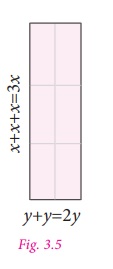
Since all the areas are same, from (1),
(2) and (3) we get,
6xy = 3x × 2y = 2y × 3x.
In our earlier discussion, we saw the
geometrical representation of 5×3 (Fig. 3.1). Here we shall replace
the second number 3 with 5.We get, 5× 5 .

We get the square number 52
=
25 , that may be represented as
52 =(3×4)
+(1×3)
+(4×2)
+(1×2)
=12+3+8+2
=25
Extending the same for variables in Fig.
3.5, the rectangular area is made into a square by making the length equal to
breadth, that is 2y is taken as 3x which becomes the side of the square.
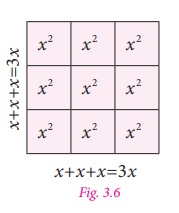
Now in Fig. 3.6 the sides are 3x and area of the square is 3x × 3x …..(4)
Also, each area is x2 and since there are 9 small squares the area of whole square is 9x2 . ...(5)
Since both the areas [(4) and (5)] are
equal, we get 3x× 3 x =9x2
.
Let us find the product of x and
(a +b). Look at the following figure.
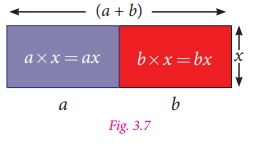
In the Fig. 3.7, the two rectangles
are combined together to form a new rectangle. Breadth of each of the rectangle
are x and their lengths are a and b. So, the length and breadth
of the new rectangle are (a +b) and x respectively.
Thus,
Area of Bigger rectangle = Area of rectangle 1 + Area
of rectangle 2
Therefore, (a +b) × x = (a ×x) + (b ×x) [Distributive property]
=ax +bx
.
Now, we can conclude that the multiplication
of two or more monomials, as given below.
Note
Product of monomials is
also a monomial.
1. If the variables are same in both
the monomials then,
* multiply the numerical co-efficient
of the two monomials, separately.
* multiply the same variable by using
the product rule of exponents, that is,
am ×
a n =am+n
. For example, x×x
=
x1 × x1 = x1+1 = x2 .
Also, 3x2 ×
2 x3 =(3× 2)(x2 × x3 ) = 6 × x2 +3 =6x5 .
2. If the variables are different in
both the monomials, then multiply them by expressing it as a product of the variables.
For example, 5x× 4y =(5×
4) ×(x×
y ) =20xy .
Try these
1. Observe the following figures and try to find its area, geometrically.
Also verify the same by multiplication of monomial.
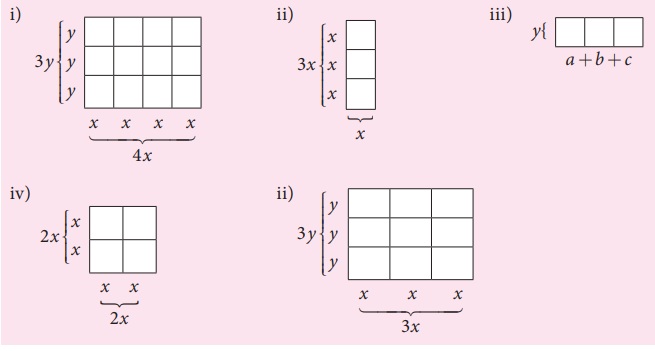
Solution:
(i) Area of each box = xy
Totally 12 boxes
∴ Total area = 12 × xy
= 12xy
Also multiplying the length 4x
and breadth 3y
We have area of the rectangle = 4x × 3y = 12xy
(ii) Area of each small box = x2
Total number of boxes = 3
∴ Total area = 3x2
Also length of the rectangle = 3x
breadth of the rectangle = x
Area of the rectangle = length × breadth
= 3x × x
= 3x2
(iii) Area of each small box is ay,
by, cy
∴ Total area = ay + by + cy
= y (a + b + c)
Area of the rectangle = length × breadth
= (a + b + c) y
(iv) Area of each small square = x2
There are 4 small squares
∴ Total area of the given square = 4x2
Also side of the big square = 2x
∴ Area of the square = (2x)2
= 4x2
(v) Area of each small rectangle = xy
There are 9 such rectangles
∴ Total area = 9xy
Area of big rectangle = length × breadth
= 3x × 3y = 9xy
2. Let the length and breadth of a tile be x and y
respectively. Using such tiles construct as many rectangles as you can and find
out the length and breadth of the rectangles so formed such that its area is
(i) 12xy (ii) 8xy (iii) 9xy
Solution:
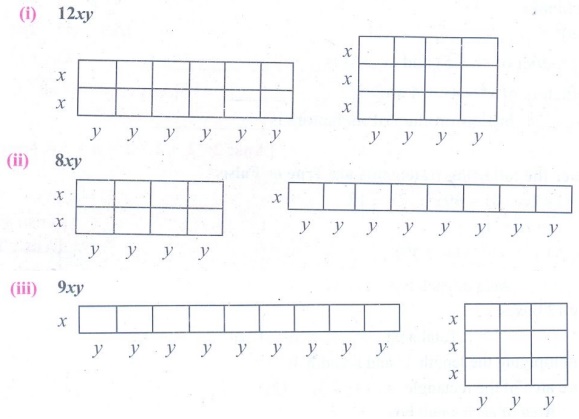
Related Topics